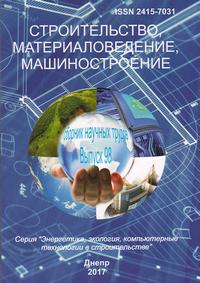Experimental study of dust removal from the coal pile
Keywords:
coal stack, contamination of work areas, physical experimentAbstract
Abstract. Purpose. Conducting a physical experiment to study the intensity of the process of removing coal dust from the coal pile model. Methodology. For the study, a model of a coal pile was created. The air flow acting on the pile model was created by a blower. During the physical experiment under laboratory conditions, the speed of air flow around the coal pile model varied. During the physical experiment, the mass of the extracted dust was determined and the data was recomputed in order to determine the amount of coal dust blown off the unit surface. Photographing of the formed contamination zones near the coal pile model was carried out. Findings. The intensity of the removal of coal dust from the pile model at different airflow velocities is determined. Data have been obtained that make it possible to estimate the intensity of coal dust emission when predicting the level of contamination of working areas at an industrial site. Originality. The intensity of the removal of coal dust from the model of a pile of coal was determined experimentally. Practical value. The results of the laboratory tests can be applied for an expert assessment of the level of contamination of working areas near the piles of coal. The data of the conducted experiments can be used as input data of the forecast models of the OND-86, the Gauss model.References
Belyaev N.N., Gunko Ye.Yu., Mashikhina P.B. Matematicheskoye modelirovaniye v zadachakh ekologicheskoy bezopasnosti i monitoringa chrezvychaynykh situatsiy [Mathematical modeling in problems of environmental safety and monitoring emergencies]. Dnepropetrovsk, Aktsent PP Publ., 2013, 159 p.
Belyayev N.N., Karpo A.A. Modelirovanie processa snosa ugolnogo koncentrata iz poluvagonov [Simulation of the process of coal concentrate out from halfwagons]. Zbirnyk naukovykh prats «Naukovyi visnyk budivnytstva» [Proc. «Scientific Bulletin of construction»], Kharkiv, 2016, issue 1 (83), pp. 196 – 199.
Belyaev N.N., Oladipo M.O. Problema unosa ugolnoj pyli [The problem of taking away the coal dust]. Nauka ta prohres transport – Science and Transport Progress, 2016, no. 6 (66), pp. 17-24. doi: 10.15802/stp2016/90450
Berlyand M.Ye. Prognoz i regulirovaniye zagryazneniya atmosfery [Prediction and regulation of air pollution]. Leningrad, Gidrometeoizdat Publ., 1985. 273 p.
Bruyatskiy Ye.V. Teoriya atmosfernoy diffuzii radioaktivnykh vybrosov [The theory of atmospheric diffusion of radioactive emissions]. Kiev, Institut gidromekhaniki NAN Ukrainy Publ., 2000. 443 p.
Kolesnik V.E., Golovina L.A., Boguckaya V.V. Matematicheskoe modelirovanie processa rasseivaniya promyshlennoj pyli v atmosfere [Mathematical modeling of industrial dust dispersion in the atmosphere]. Dnepropetrovsk, Zbirnyk naukovykh prats NGU [Proc. of NMU], 2006, no. 26 (2), pp. 120-130.
Marchuk G.I. Matematicheskoye modelirovaniye v probleme okruzhayushchey sredy [Mathematical modeling in the environmental problem]. Moscow, Nauka Publ., 1982. 320 p.
Uork, K., Uorner S. Zagryazneniye vozdukha. Istochniki i kontrol [Air pollution. Sources and control]. Moscow, Mir Publ., 1980. 539 p.
Zgurovskiy M.Z., Skopetskiy V.V., Khrushch V.K., Belyaev N.N. Chislennoye modelirovaniye rasprostraneniya zagryazneniya v okruzhayushchey srede [Numerical modelling of pollution spreading in the environment]. Kyiv, Naukova dumka Publ., 1997. 368 p.
Biliaiev, M. Numerical Simulation of Indoor Air Pollution and Atmosphere Pollution for Regions Having Complex Topography / M. Biliaiev // NATO Science for Peace and Security Series C: Environmental Security. – 2012. – P. 87–91. doi: 10.1007/978-94-007-1359-8_15.
Ferreira, AD, Viegas, DX, & Sousa, ACM. (2003). Full-scale measurements for evaluation of coal dust release from train wagons with two different shelter covers. Journal of Wind Engineering and Industrial Aerodynamics, 91(10), 1271-1283. doi: 10.1016/S0167-6105(03)00077-1.
Initial Report on the Independent Review of Rail Coal Dust Emissions Management Practices in the NSW Coal Chain / Chief Scientist & Engineer. – Sydney NSW, Australia, 2015. – 75 p.
I.Diego, A. Pelegry ,S. Torno, J. Torano, M. Menendez. Simultaneous CFD evaluation of wind flow and dust emission in open storage piles / Applied Mathematical Modeling 33 (2009), 3197 – 3207.
Szabo, M.F. Environmental assessment of coal transportation / M. F. Szabo. – Cincinnati, Ohio : Environmental Protection Agency, 1978. – 142 р.
Downloads
Published
Issue
Section
License
Редакція Видання категорично засуджує прояви плагіату в статтях та вживає всіх можливих заходів для його недопущення. Плагіат розглядається як форма порушення авторських прав і наукової етики.
При виявлені у статті більш ніж 25% запозиченого тексту без відповідних посилань та використання лапок, стаття кваліфікується як така, що містить плагіат. У цьому випадку стаття більше не розглядається редакцією, а автор отримує перше попередження.
Автори, в статтях яких повторно виявлено плагіат, не зможуть публікуватися в усіх журналах Видавництва ДВНЗ «Придніпровська державна академія будівництва та архітектури».
Автори, які публікуються у цьому журналі, погоджуються з наступними умовами:
- Автори залишають за собою право на авторство своєї роботи та передають журналу право першої публікації цієї роботи на умовах ліцензії Creative Commons Attribution License, котра дозволяє іншим особам вільно розповсюджувати опубліковану роботу з обов'язковим посиланням на авторів оригінальної роботи та першу публікацію роботи у цьому журналі.
- Автори мають право укладати самостійні додаткові угоди щодо неексклюзивного розповсюдження роботи у тому вигляді, в якому вона була опублікована цим журналом (наприклад, розміщувати роботу в електронному сховищі установи або публікувати у складі монографії), за умови збереження посилання на першу публікацію роботи у цьому журналі.
- Політика журналу дозволяє і заохочує розміщення авторами в мережі Інтернет (наприклад, у сховищах установ або на особистих веб-сайтах) рукопису роботи, як до подання цього рукопису до редакції, так і під час його редакційного опрацювання, оскільки це сприяє виникненню продуктивної наукової дискусії та позитивно позначається на оперативності та динаміці цитування опублікованої роботи (див. The Effect of Open Access).

